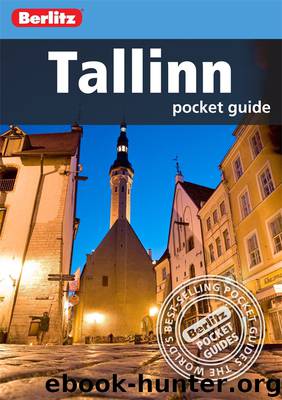Berlitz: Tallinn Pocket Guide by Berlitz Travel

Author:Berlitz Travel
Language: eng
Format: epub
Tags: Travel, Tallinn
Publisher: APA
Published: 2013-09-14T04:00:00+00:00
Tartu
Its nickname is ‘the city of good thoughts’, but a better name for Tartu • [map], a minor metropolis 189km (118 miles) southeast of Tallinn, might be ‘the city of good ideas’. Tartu is Estonia’s intellectual capital, home not only to the nation’s largest and most prestigious educational institution, Tartu University, but also to several colleges, research centres and the nation’s supreme court.
The atmosphere here is decidedly different from that in Tallinn – less rushed, more contemplative and, thanks to its student population, visibly younger. With 103,000 inhabitants, this is Estonia’s second-largest city, but Tartu is still small enough to lack the annoyances found in many urban areas. At the same time it has a number of cafés, parks, museums and historic sites that are just as interesting as any you could find in the capital.
As in Tallinn, the heart of Tartu is its Old Town, where the city’s most striking architecture is concentrated. Unlike Tallinn, though, Tartu’s Old Town no longer has a medieval look – constant wars during the 17th century and the Great Fire of 1775 mean that most of what you see here was built in the late 18th and 19th centuries. Your first Old Town destination should be Town Hall Square (Raekoja plats), the centre of Tartu from time immemorial. The Town Hall (Raekoda) presiding over the top of the square was opened in 1786 and its design reflects a mixture of early classicism, baroque and rococo. The building is home to the Tourist Information office. The mischievous fountain directly in front of the Town Hall, Kissing Students, is a relatively recent installation, but has already become a favourite symbol of the town.
Further down the square is Tartu’s Leaning Tower of Pisa, the Tartu Art Museum (www.tartmus.ee; Wed–Sat noon–6pm, Sun 11am–6pm; charge), which tilts bizarrely to the left due to the soft riverbank mud on which it stands. The nearby arched bridge over the Emajõgi River replaced the 18th-century stone bridge that was destroyed in 1944. Taking a daring walk over the arched bridge’s top rail has become a student tradition.
Just off the square from the Town Hall you’ll find one of the most outstanding examples of neoclassical architecture in Estonia, the Tartu University Main Building. The Swedish King Gustav Adolph established Tartu University in 1632, and this structure was completed in 1809. The building houses an impressive concert hall, an art museum (Mon–Fri 11am–6pm; charge) whose collection of antiquities includes a 4,000-year-old Egyptian mummy, and a Student Lock-up, where students were incarcerated for bad conduct. Not far away is Old Town’s principal church, St John’s Church (Jaani Kirik), which dates back to the late 12th century and is renowned for its more than 1,000 terracotta figures.
A short climb up Toome Hill (Toomemägi) brings you to the towering brick ruins of Dome Cathedral. Built in the 13th century, the cathedral served as the centre of a regional bishopric prior to the Reformation. Fire destroyed it in 1624. A restored section now houses the extensive Museum of Tartu University History (www.
Download
This site does not store any files on its server. We only index and link to content provided by other sites. Please contact the content providers to delete copyright contents if any and email us, we'll remove relevant links or contents immediately.
Spell It Out by David Crystal(35858)
Underground: A Human History of the Worlds Beneath Our Feet by Will Hunt(11850)
A Year in the Merde by Stephen Clarke(5083)
Venice by Jan Morris(2445)
Claridge's: The Cookbook by Nail Martyn & Erickson Meredith(2265)
My Paris Kitchen: Recipes and Stories by Lebovitz David(2136)
A TIME OF GIFTS by Patrick Leigh Fermor(2107)
The Plantagenets by Dan Jones(1935)
Welcome to the Goddamn Ice Cube by Blair Braverman(1889)
Bang Poland: How To Make Love With Polish Girls In Poland by Roosh V(1864)
Top 10 Prague (EYEWITNESS TOP 10 TRAVEL GUIDES) by DK(1855)
The Finnish Way by Katja Pantzar(1813)
The Isle of Mull by Terry Marsh(1808)
From Russia with Lunch by David Smiedt(1800)
A TIME TO KEEP SILENCE by Patrick Leigh Fermor(1776)
Rick Steves London 2018 by Rick Steves & Gene Openshaw(1753)
A Taste of Paris by David Downie(1748)
Merde in Europe by Stephen Clarke(1674)
Insight Guides Experience Tokyo by Insight Guides(1662)
